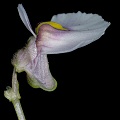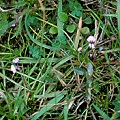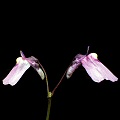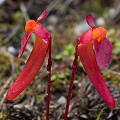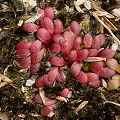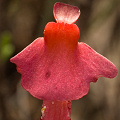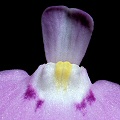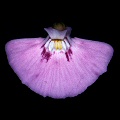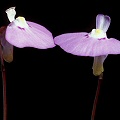| Utricularia section Pleiochasia | ||
|---|---|---|
| Species | Range | Habit1 |
| U. albertiana2 | nw Australia | T/AA |
| U. albiflora | n Australia | T |
| U. antennifera2 | w Australia | T |
| U. arnhemica | n Australia | T/AA |
| U. barkeri | se Australia | T |
| U. beaugleholei | se Australia | T/AA |
| U. benthamii | sw Australia | T |
| U. bidentata | nw Australia | T |
| U. blackmanii | n Australia | T |
| U. byrneana | nw Australia | T |
| U. capilliflora2 | nw Australia | T |
| U. cheiranthos | nw Australia | T |
| U. dichotoma | Australia, NZ, NC | T |
| U. dunlopii2 | nw Australia | T |
| U. dunstaniae2 | nw Australia | T |
| U. fistulosa | nw Australia | AA |
| U. georgei | nw Australia | T |
| U. grampiana | se Australia | T |
| U. hamata | nw Australia | T/AA |
| U. hamiltonii | nw Australia | AA |
| U. helix | sw Australia | AA |
| U. holtzei | nw Australia | T/AA |
| U. inaequalis | sw Australia | T |
| U. kamienskii | nw Australia | T |
| U. kenneallyi | nw Australia | T |
| U. kimberleyensis | nw Australia | T |
| U. lasiocaulis | n Australia | T |
| U. leptorhyncha | nw Australia | T |
| U. limmenensis | nw Australia | T |
| U. linearis | nw Australia | AA |
| U. lowriei | ne Australia | T/AA |
| U. magna | nw Australia | T |
| U. menziesii | sw Australia | T |
| U. papilliscapa | nw Australia | T |
| U. paulineae | sw Australia | T |
| U. petertaylorii | sw Australia | T |
| U. quinquedentata | n Australia | T |
| U. rhododactylos | nw Australia | T/AA |
| U. singeriana | nw Australia | T |
| U. terrae-reginae | ne Australia | T |
| U. tridactyla | nw Australia | T |
| U. triflora | nw Australia | T |
| U. tubulata | n Australia | SA |
| U. uniflora | se Australia | T |
| U. violacea | s Australia | T |
| U. volubilis | sw Australia | AA |
| U. wannanii2 | nw Australia | T/AA |
|
1T=terrestrial; AA=affixed aquatic; SA=suspended aquatic. 2Species with erect antennae, emerging from the upper or lower corolla lobes. |
||
Q: About Utricularia subgenus Polypompholyx section
Pleiochasia
A: This Utricularia section is almost exclusively restricted to
Australia, and is a very natural group of plants that share a number of similarities. All the traps are more or less similar,
and furthermore are either at the ends of the leaves or on special stalks emerging from the peduncle base (i.e. they are not
scattered willy-nilly, as is usually the case in the genus). The flower peduncles never bear scales, and (with almost
no exceptions) the flowers are always either solitary or in whorls of two or more.
However, there is plenty of room for interesting variation within this very large section. The flowers come in a great variety of
colors and form, and the floral bracts have a wide variety. Also, the section includes a few extreme oddities like
U. menziesii and U. tubulata.
Ellison & Adamec (2018) suggest major changes in this section--most importantly, they split this into two sections.
The changes are involved enough that I summarize them on the next page, while keeping my older treatment of Pleiochasia
unchanged here.
Utricularia arnhemica
This is one of a small set of plants in the genus that is struggling for
the status of having the largest bladders. Some are up to 1.2 cm across! Other species with enormous bladders are
Utricularia humboldtii and Utricularia reflexa.
Utricularia capilliflora
A species which must have evolved to beguile an as-yet unknown insect for pollination
purposes, it has a flower that looks like cartoon of a frightened bug. The lower corolla lip has been transformed into
five insect-leg-looking, threadlike lobes. The upper corolla lip has transformed into a par of tall, erect antennae. This plant
is similar to the related U. dunlopii. The
spur....uh....is doubly bulged and is described as "scrotiform." I agree.
Utricularia dichotoma
The only species in the group that ventures off Australia--it also occurs in
New Zealand and New Caledonia. The species formerly known as Utricularia novae-zelandiae and
Utricularia monanthos (both of which I loved very much) have been grouped into this species--a bitter
decision I have taken years to accept. The flowers of this species are often delicately and attractively scented. This is
the easiest plant in the section to grow, in my experience.
The species Utricularia ameliae R.W.Jobson and Utricularia fenshamii R.W.Jobson
are tentatively treated as a variety of this plant.
Utricularia dunstaniae
Another of the six species in the genus that have curiously insect-like
flowers because of erect antennae-like flower lobes. However, unlike in U. capilliflora, U. dunlopii
or U. lowriei, the "antennae" of this plant emerge from the lower corolla lip. The rest of
the flower is highly reduced, like U. antennifera and U. albertiana.
Utricularia fistulosa
A small flowered species with a comparatively large spur. A fairly
unmemorable plant that is not all that much. I mention it only because I really like the plant's name.
It rolls off the tongue quite dramatically.
Also, it seems likely that U. linearis Wakabayashi is a collection of this species.
Utricularia menziesii
This is perhaps one of the strangest species in the entire genus.
The flowers are beautifully bright red and yellow, and have an enormous drooping, fat spur that dominates the plant's appearance.
The rosette of leaves is comparatively small and inconspicuous. What really makes this plant peculiar is the presence of underground
tubers at the inflorescence rosette that helps the plant survive dry periods.
Utricularia tubulata
Here in a genus of terrestrial and sub-affixed plants, we find this
entirely aquatic species with leaves in whorls. It has strange seeds which are covered with elongated bumps that I am struggling
to try to explain--imagine stubby little fingers (botanically they are called papillae). The flowers are on long,
fat inflorescences, and have delicate spurs. A true oddity. I cannot say I am convinced by Taylor's reasoning to place this species
into this section.
Utricularia uniflora
Very similar to Utricularia dichotoma in form,
this plant has really wonderful flowers that look to me like little butterflies flitting in the air. I am particularly fond
of this species.
Utricularia volubilis
This is a notheworthy plant I have grown on a few occasions as an affixed
aquatic. It has long leaves that are arranged in a rosette, and each rosette produces long stolons that produce additional
plantlets.
Page citations: Adamec, L. 2006 (pers. comm.); Fleischmann, A. 2015; Jobson, R.W. 2012, 2013;
Jobson, R.W. et al. 2018;
Rice, B.A. 2006a; Taylor, P. 1989; Wakabayashi, H. 2010b; personal observations.
